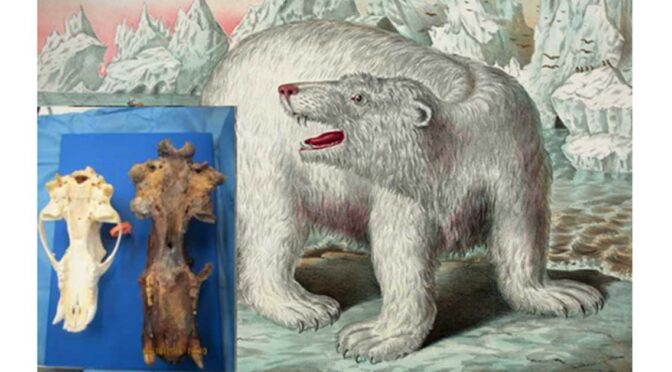Enormous Skull Found in Alaska May Belong to the Legendary King Bear of Inuit Mythology
An enormous, elongated polar bear skull emerged in 2014 from an eroding archaeological site southwest of Utqiaġvik in Alaska. Experts claim that it is quite different from most modern polar bear skulls and reassure that it is one of the biggest polar bear skulls ever found.
Inuvialuit Hunters and the “Weasel Bear”
Inuvialuit have been hunting polar bears – nanuq – in Canada’s Western Arctic for many decades. Passing knowledge and understanding of polar bear hunting from one generation to the next, based on experience, is the very foundation of Inuvialuit wisdom and tradition.

Inuvialuit hunters have seen hundreds of bears during their lifetime and have taken high risks, since polar bear hunting is an extremely dangerous endeavor. However, their passion and need for survival doesn’t leave them many other choices.
If you get a chance to be around them, you will definitely hear them talking about “tiriarnaq” or “tigiaqpak” (meaning weasel bear), an incredibly unique polar bear that is enormous, narrow-bodied and moves fast like a demon.
Oral history and traditional knowledge in Inuit culture talks about “weasel” or “king” bears, and the huge, fully intact and unusually shaped polar bear skull that emerged in 2014 from an eroding archaeological site near Utqiaġvik has added more fuel to the fire.

One of the Biggest and Most Distinct Polar Bear Skulls Ever Found
According to Anne Jensen, an Utqiaġvik-based archaeologist and leader of the excavation and research programs in the region, this is one of the biggest polar bear skulls ever found, and it appears to be different from most modern polar bear skulls. It is slender, elongated in the back and has uncommon structural features around the nasal and other areas.
“It looks different from your average polar bear,” said Anne Jensen , and added that after radiocarbon dating she and her colleagues estimate that the big bear skull comes from the period between the years 670 and 800 AD.
Despite looking different, scientifically it’s not determined yet what makes this skull differ from other found polar bear skulls and genetic testing is needed at this point to provide the scientists with more details.
“It could have been a member of a subspecies or a member of a different “race” in genetic terms — similar to the varying breeds that are found among dogs — or possibly something else entirely,” said Jensen as adn.com reports.

The Skull is Just One of the Many Newly Found Treasures
Even though the majority of the scientific world has focused almost entirely on the curiously enormous polar bear skull, the excavation of the now-eroding site, which is called Walakpa, has been successful in spotting a number of other archaeological treasures.
The excavation of the site uncovered another first for Alaska, four mummified seals, naturally preserved in an old ice cellar. Jensen’s team was able to recover one of them last summer, an adult female that was named Patou.
Jensen said , “The excavated seal was much more modern than the polar-bear skull, dating back to only the mid-1940s. Still, it and the other seals amounted to a startling find: They are the only mummified seals ever discovered outside of Antarctica’s Dry Valley.”

Jensen also expressed her satisfaction with the new finds, since she was one of the many people who believed the Walakpa site had already been thoroughly excavated back in the late 1960’s, when Smithsonian anthropologist Dennis Stanford excavated the area for the first time.
As she says, “Everyone had the opinion — I was one of them — that he had pretty well excavated the site and there was nothing left to be done.”
Finally, the closed-up site was also considered to be intact and pretty much safe from erosion and thaw, which wasn’t the case at all – as Jensen and her colleagues told adn.

